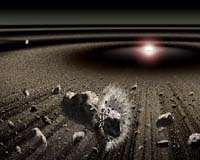 |
Pasadena CA (JPL) May 13, 2011 The Spacecraft Assembly Facility of NASA's Jet Propulsion Laboratory in Pasadena, Calif., was constructed in 1961 to support NASA's Ranger and Mariner missions to the moon, Venus and Mars. America had entered the Space Age just three years earlier, with the launch of the JPL-built Explorer 1 spacecraft. The Spacecraft Assembly Facility, also known as JPL Building 179, originally had just one high bay, the large chamber now named High Bay 1. It is about 80 feet by 120 feet (about 24 by 36 meters). In contrast to the cleanliness standards for spacecraft assembly today, in the early days of the facility, personnel were even permitted to smoke inside this high bay. All JPL-built spacecraft through the Viking Orbiters (launched to Mars in 1975) were built in High Bay 1. At times during the 1960s, as many as five different spacecraft were being assembled at the same time in the facility. After the original construction of the high bay, the System Test Complex on the south side of the high bay's windows was added. A second high bay, about 70 feet by 70 feet (21 meters by 21 meters) was finished in 1976 to support the Voyager Project. Spacecraft assembled in High Bay 2 have included Voyager 1 and 2, Galileo and Cassini. The project being assembled and tested in High Bay 1 in spring 2011 is the Mars Science Laboratory, including its rover, Curiosity. The mission is scheduled for launch in November 2011. Mars rovers Spirit and Opportunity were also built in High Bay 1. Emblems on the wall of High Bay 1 represent all the missions (spacecraft and instruments) that were assembled in the Spacecraft Assembly Facility, regardless of which high bay was used. These include the first successful missions to Venus, Mars, Jupiter, Saturn, Uranus and Neptune, as well as Earth's moon. The facility has also built Earth-science instruments, plus Wide Field and Planetary Cameras that flew on the Hubble Space Telescope. Both of the high bays are certified to a cleanliness level of Class 10,000, which means that there are less than 10,000 particles of 0.5 micron (half a millionth of a meter or yard) or larger in size per cubic foot of air volume. It is a great place to work if you have allergies. The filtration systems in the high bays are effective in reducing both particulates as well as hydrocarbons. The system maintained acceptable levels even when a brush fire raged near JPL in 2009. Personnel working in the high bay wear protective clothing to minimize particles and bacteria reaching the spacecraft and the facility. All the equipment that enters the high bay is cleaned first with approved solvents (usually isopropyl alcohol). Both high bays are equipped with continuous remote monitoring for environmental conditions and cleanliness levels to ensure system safety and quick response to anomalous conditions. See it at JPL Open House May 14 and 15.
Share This Article With Planet Earth
Related Links JPL Space Tourism, Space Transport and Space Exploration News
 NASA Selects 'Whipple' Mission for Technology Development
NASA Selects 'Whipple' Mission for Technology DevelopmentBoston MA (SPX) May 10, 2011 As part of its Discovery Program, NASA has selected three potential missions for 2016 that would look at Mars' interior for the first time; study an extraterrestrial ocean on one of Saturn's moons; and study in unprecedented detail the surface of a comet's nucleus. Three technology developments for future planetary missions also were selected. Among them was Whipple, a mission proposed by the Ha ... read more |
|
| The content herein, unless otherwise known to be public domain, are Copyright 1995-2010 - SpaceDaily. AFP and UPI Wire Stories are copyright Agence France-Presse and United Press International. ESA Portal Reports are copyright European Space Agency. All NASA sourced material is public domain. Additional copyrights may apply in whole or part to other bona fide parties. Advertising does not imply endorsement,agreement or approval of any opinions, statements or information provided by SpaceDaily on any Web page published or hosted by SpaceDaily. Privacy Statement |